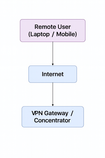VPN Scalability: Building Secure and Expandable Remote and Site-to-Site Networks
- The Itvue Team
- Aug 25
- 2 min read
Author Ermias Teffera
At ITVue Networks, we understand that as businesses grow, their VPN infrastructure must scale to support more users, sites, and services without compromising security, performance, or reliability. Whether it’s remote access VPN for employees or site-to-site VPNs connecting multiple branches, scalability is a key consideration for modern enterprise networks.
1. What is VPN Scalability?
VPN scalability refers to the ability of a VPN solution to support increasing numbers of users, devices, and sites while maintaining:
High performance: Minimal latency and packet loss
Security: Consistent encryption and access control policies
Reliability: Redundancy and failover for critical connections
Manageability: Easy provisioning and monitoring
2. Factors Affecting VPN Scalability
a) Number of Users / Endpoints
For remote access VPN, each user consumes bandwidth and VPN gateway resources.
Solutions must handle peak loads during work-from-home or mobile access spikes.
b) Number of Sites
Site-to-Site VPNs must efficiently route traffic between multiple offices.
Full-mesh configurations grow complex; scalable architectures often use hub-and-spoke or route reflectors for VPN routing.
c) Bandwidth and Performance
The VPN infrastructure must provide sufficient throughput for all users.
High-performance devices or appliances may be required for IPsec encryption/decryption at scale.
d) Encryption Overhead
Strong encryption (AES-256, SHA-2) adds CPU load on gateways.
Larger networks may require hardware-accelerated VPN devices to maintain performance.
3. VPN Scalability Solutions
a) Load Balancing VPN Gateways
Deploy multiple VPN gateways in active-active or active-standby configurations.
Distribute remote user connections across gateways to prevent bottlenecks.
b) Hierarchical VPN Architecture
Hub-and-Spoke for site-to-site VPNs: Central hub handles traffic aggregation.
Full-mesh route optimization for smaller deployments; use dynamic routing (BGP/OSPF) to manage paths.
c) Split Tunneling
Allows non-sensitive traffic to bypass the VPN, reducing load on VPN devices.
d) MPLS and Layer 2/3 VPNs for Sites
Use MPLS L3VPN or VPLS to connect multiple sites efficiently.
Supports scalable multipoint connections without requiring full-mesh IPsec tunnels.
4. Diagram: Scalable VPN Architecture.

Multiple VPN gateways handle large remote user pools.
Core gateways connect to branch offices via site-to-site VPN tunnels.
MPLS or VPLS can be used for multipoint branch connectivity.
5. Best Practices for VPN Scalability
Plan for Peak Loads: Anticipate high concurrency for remote access VPNs.
Use Load-Balanced Gateways: Distribute user connections to avoid bottlenecks.
Segment Users and Sites: Different VPNs for different business units or applications.
Implement Redundancy: Dual gateways and failover tunnels for uninterrupted connectivity.
Monitor and Optimize: Use VPN monitoring tools to track bandwidth, latency, and device CPU usage.
Leverage MPLS or VPLS: For scalable site-to-site connectivity with reduced tunnel complexity.
6. Real-World Example
Enterprise with 5,000 remote employees: Multiple VPN gateways handle peak logins, split-tunneling reduces non-business traffic, and load balancing ensures consistent performance.
10 branch offices across the country: MPLS L3VPN connects all sites, central VPN hub aggregates traffic and applies consistent security policies.
Disaster Recovery Sites: Redundant VPN gateways provide failover and business continuity.
7. Conclusion
VPN scalability is essential for enterprises growing in size, geography, and workforce. By leveraging load-balanced gateways, hierarchical architectures, MPLS/VPLS for sites, and proper monitoring, ITVue Networks ensures that VPN infrastructures remain secure, reliable, and high-performing, even as usage scales dramatically.









